
UVC + INCANDESCENT LAMP
UVC + Incandescent Lamp, retail $(Unknown)
Manufactured by (Unknown)
Last updated 05-21-21
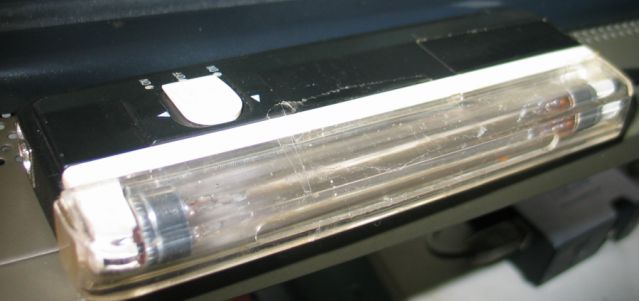

This is a small, self-contained lamp that has a UVC (ultraviolet-C) fluorescent tube for sanitising/disinfecting things and a prefocused incandescent light bulb so that it can be used as a flashlight.
It comes in a black plastic body, and feeds from four AA cells.
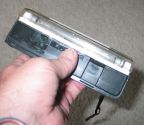 SIZE
SIZE

To use this product, feed it four AA cells first (see directly below(, and then you can commit first degree murder of dust mites & microbes in your mattress or telphone handset.
On the side of the product's body near the front (where the incandescent light is), you'll see a large, light grey slide switch. Slide it forward (toward the flashlight end) to turn the incandescent flashlight on.
Slide it back (toward the end with the battery door) to turn the UVC fluoro. tube on.
The plastic tube cover has an open slot on it to allow the UVC radiation to escape and do its thing.
Slide it to the center position to extinguish both lamps.
***YOU MUST NOT*** look directly at the fluorescent tube; although most prescription eyeglasses will block a significant portion of UVC radiation, I cannot guarantee that this will be the case.

Slide the battery door off the end of the unit, gently place it on the ground, and kick it into the garden where the praying mantids will think it's something yummy to eat, and strike at it...O WAIT!!! YOU'LL NEED THAT!!!
So just set it aside instead. 
Remove the four used AA cells from the battery compartment, and dispose of or recycle them as you see fit.
Insert four new AA cells into the compartment, orienting them as shown in the photograph directly below. Each cell behind the visible one goes in the same way (so they're oriented back-to-front).
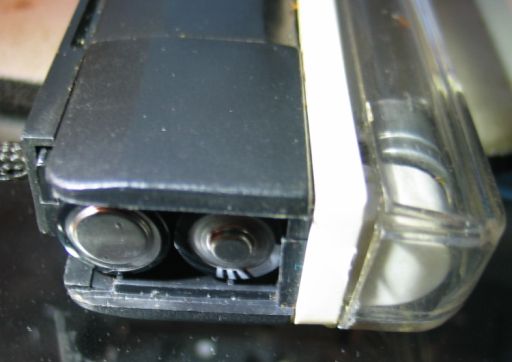
Slide the battery door back on; pushing in on the edge of it until it clicks, and be done with it.
Aren't you glad you didn't kick that battery door into the garden with all those hungry, hungry praying
mantids now? 
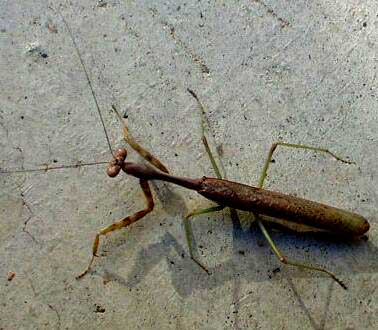
Here is what a praying mantis looks like.
I found this guy on the morning of 09-08-06 clinging to the basket of my scooter.
Current usage measures 334mA (incandescent) and 519mA (fluorescent) on my DMM's 4A (4 amps) scale.
Because this product has an incandescent bulb in it, sooner or later that bulb will require changing.
However, I have not yet figured out how to do this.

The UVC + Incandescent Lamp was designed to be used as a disinfecting device with an occasional-use flashlight built in as a convenience; it was not designed as an EDC (Everyday Carry) flashlight meant to be carried around every bloody day, thrashed, trashed, and abused, so I won't try to drown it in the toliet tank, bash it against a steel rod or against the concrete floor of a patio, let my housemate's citty kats  go to the litterbox on it, run over it with a 450lb Celebrity motorised wheelchair, stomp on it, use a large claw hammer in order to bash it open to check it for candiosity, fire it from the cannoñata (I guess I've been watching the TV program "Viva Piñata" too much again
go to the litterbox on it, run over it with a 450lb Celebrity motorised wheelchair, stomp on it, use a large claw hammer in order to bash it open to check it for candiosity, fire it from the cannoñata (I guess I've been watching the TV program "Viva Piñata" too much again  - candiosity is usually checked with a laser-type device on a platform with a large readout (located at Piñata Central), with a handheld wand that Langston Lickatoad uses, or with a pack-of-cards-sized device that Fergy Fudgehog uses; and the cannoñata (also located at Piñata Central) is only used to shoot piñatas to piñata parties away from picturesque Piñata Island), send it to the Daystrom Institute for additional analysis, or perform other indecencies on it that a flashlight might have to have performed on it. So this section of the web page will be significantly more bare than this section of the web page on a page about a flashlight.
- candiosity is usually checked with a laser-type device on a platform with a large readout (located at Piñata Central), with a handheld wand that Langston Lickatoad uses, or with a pack-of-cards-sized device that Fergy Fudgehog uses; and the cannoñata (also located at Piñata Central) is only used to shoot piñatas to piñata parties away from picturesque Piñata Island), send it to the Daystrom Institute for additional analysis, or perform other indecencies on it that a flashlight might have to have performed on it. So this section of the web page will be significantly more bare than this section of the web page on a page about a flashlight.
In fact, the photographs plus spectrographic & beam cross-sectional analyses below may be pretty much it.
The main "disinfecting" component here is the ultraviolet-C wavelength comprising mainly of the mercury line at 253.7nm.
A small amount of "vacuum UV" (wavelengths shorter than ~200nm) is produced; this is evident for the following reason:
A faint odour of ozone ( ) is evident near the bulb when the unit is in operation.
) is evident near the bulb when the unit is in operation.
Because UVC and some "vacuum UV" wavelengths are produced, there's a fairly high likelihood that the tube envelope is made of quartz, rather than regular "light bulb glass". This is because the glass used in making light bulbs blocks virtually ***ALL*** UVC and ***ALL*** "vacuum UV" wavelengths; and since these wavelengths are allowed to pass (well, they SHOULD considering that this is a germicidal lamp!!!), I'm fairly certain that the tube material is something other than "light bulb glass".

Here's a photograph of the tube itself, while energized.
This photograph makes the glow appear significantly brighter and whiter than it really is.

And here's a photograph, showing the warning printed on the flurorescent tube glass itself. This photograph renders the brightness much more correctly; though the color is a little too violet.
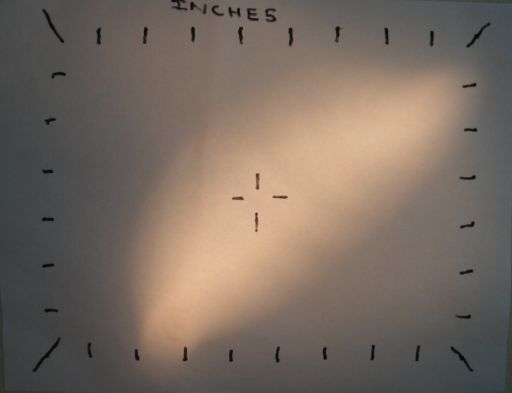
Photograph of the incandescent on the test target at ~12".
Measures 43.80cd on a Meterman LM631 (now Amprobe LM631A) light meter.
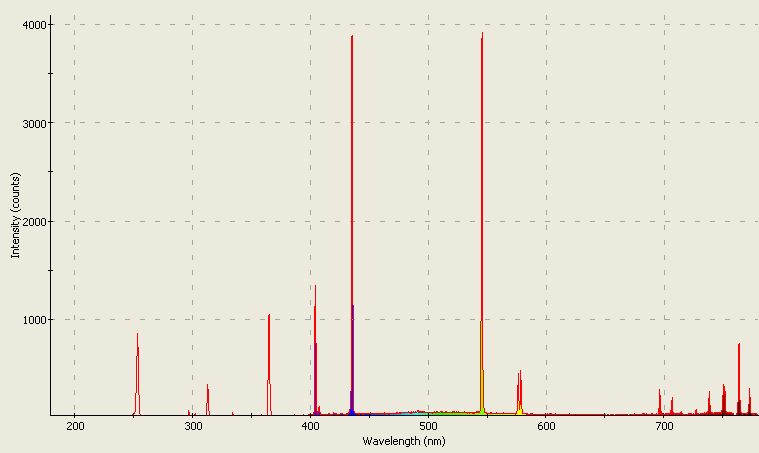
Spectrographic analysis of the UVC fluoro. tube.
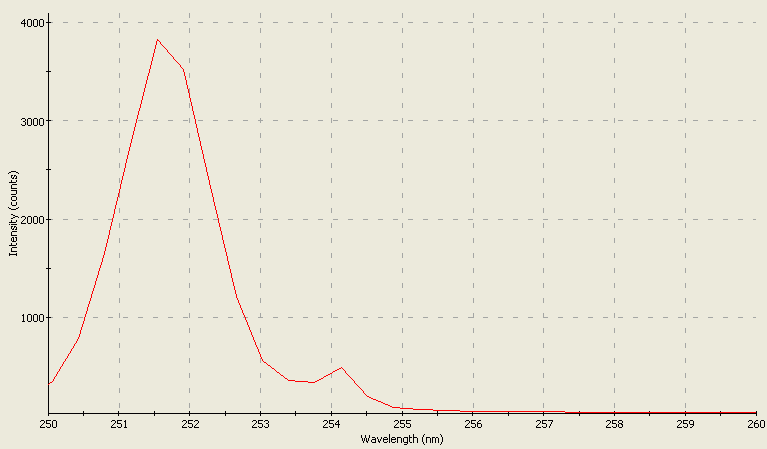
Same as above; spectrometer's response band narrowed to a range of 250nm to 260nm to show the 253.7nm mercury line.
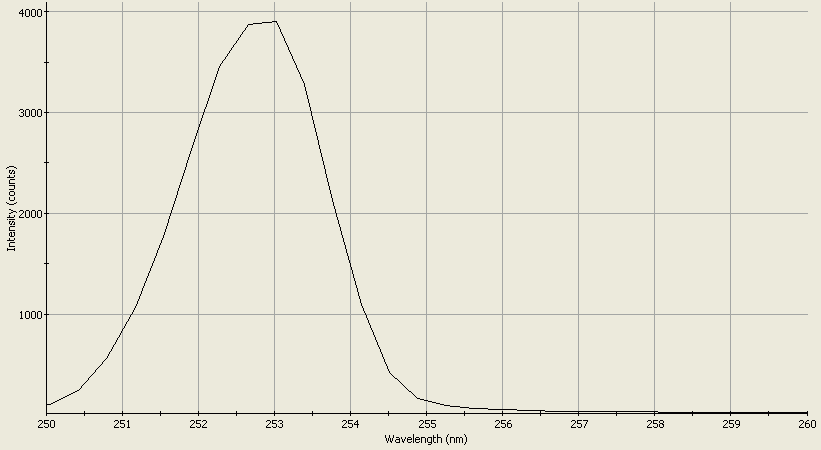
Same as above; newer spectrometer software & settings used.
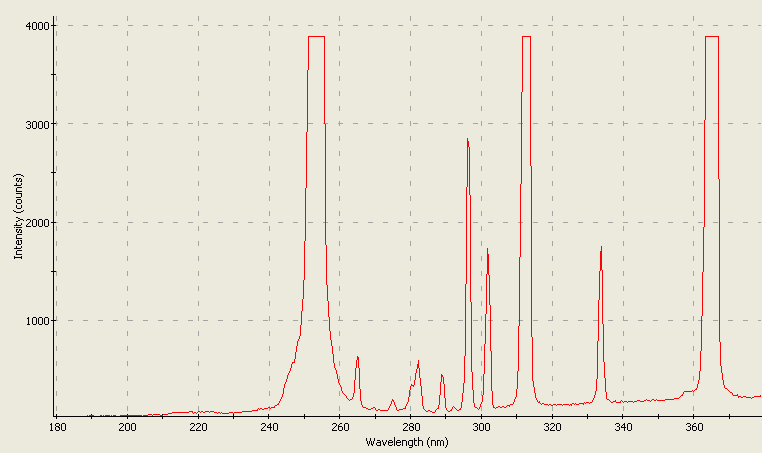
Same as above; spectrometer's response band narrowed to a range of 179nm to 379nm and deliberately "overexposed" to show alternate UV spectral lines.
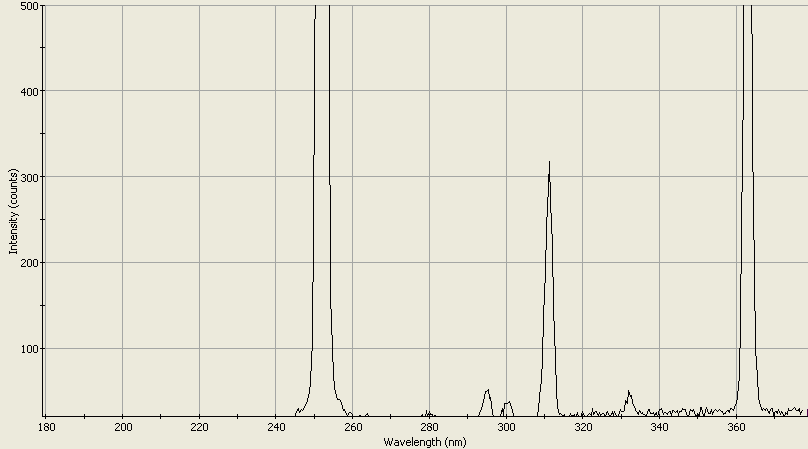
Same as above; newer spectrometer software & settings used.
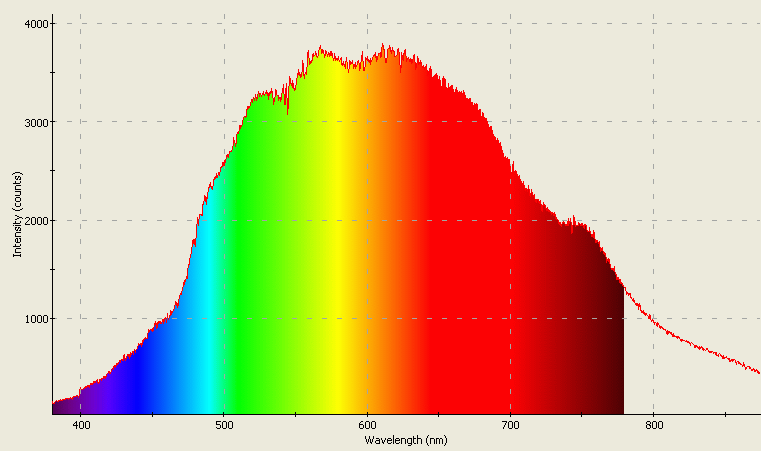
Spectrographic analysis of the incandescent portion of this product.
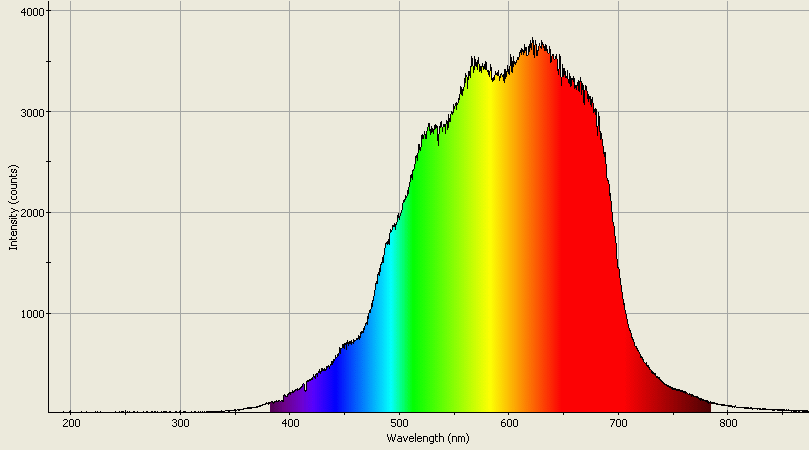
Same as above; newer spectrometer software & settings used.
USB2000 spectrometer graciously donated by P.L.
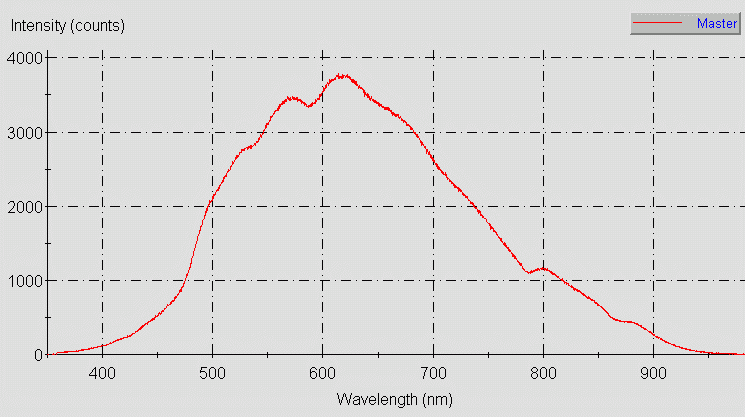
Spectrographic analysis of the incandescent portion of this product; different spectrometer used to "dig" a bit deeper into the NIR range.
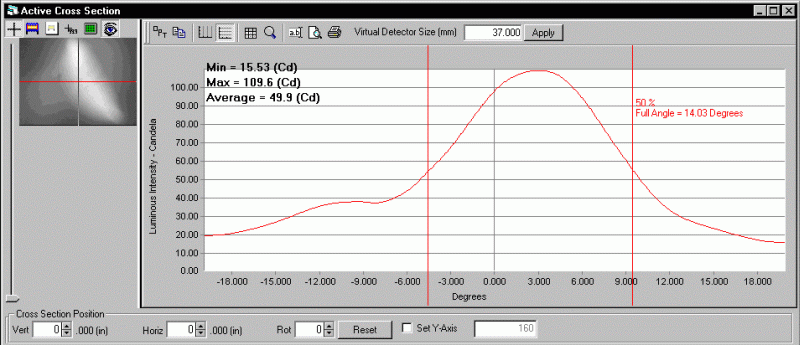
Beam cross-sectional analysis of the incandescent.
Image made using the ProMetric System by Radiant Imaging.
TEST NOTES:
Test unit was purchased on Ebay on 07-01-04, and was received on received on 07-13-04.
UPDATE: 00-00-00
PROS:
Handy 2-in-1 product allows you to see what you're going to sanitise
Decent "intensity" from the UVC fluoro. tube
Uses batteries that are common and relatively inexpen$ive
CONS:
Not very water-resistant and not submersible AT ALL
Flashlight beam (from the incandescent bulb) is a little "wonky"

MANUFACTURER: Unknown
PRODUCT TYPE: "2-in-1" fluorescent UVC unit plus incandescent flashlight
LAMP TYPE: Linear UVC fluoro. tube, prefocused incandescent bulb
No. OF LAMPS: 2 (1 each fluoro. & incan.)
BEAM TYPE: Broad flood (fluoro.), medium line-shaped spot (incan)
SWITCH TYPE: Slide on/off on side of product
CASE MATERIAL: Plastic
BEZEL: Water-clear plastic shield over fluoro.; incan. is inset into reflector for it
BATTERY: 4 AA cells
CURRENT CONSUMPTION: 334mA (incandescent) and 519mA (fluorescent)
WATER RESISTANT: Light splatter-resistance at absolute maximum
SUBMERSIBLE: NO WAY HOZAY!!! 
ACCESSORIES: Small wrist strap
WARRANTY: Unknown/not stated
PRODUCT RATING:



UVC + Incandescent Lamp *
Do you manufacture or sell an LED flashlight, task light, utility light, or module of some kind?
Want to see it tested by a real person, under real working conditions? Do you then want to see how your light did? If you have a sample available for this type of
real-world, real-time testing, please contact me at bdf1111@yahoo.com.
Please visit this web page for contact information.
Unsolicited flashlights, LEDs, and other products appearing in the mail are welcome, and it will automatically be assumed that you sent it in order to have it tested and evaluated for this site.
Be sure to include contact info or your company website's URL so visitors here will know where to purchase your product.
This page is a frame from a website.
If you arrived on this page through an outside link,you can get the "full meal deal" by clicking here.




 SIZE
SIZE







 go to the litterbox on it, run over it with a 450lb Celebrity motorised wheelchair, stomp on it, use a large claw hammer in order to bash it open to check it for candiosity, fire it from the cannoñata (I guess I've been watching the TV program "Viva Piñata" too much again
go to the litterbox on it, run over it with a 450lb Celebrity motorised wheelchair, stomp on it, use a large claw hammer in order to bash it open to check it for candiosity, fire it from the cannoñata (I guess I've been watching the TV program "Viva Piñata" too much again  - candiosity is usually checked with a laser-type device on a platform with a large readout (located at Piñata Central), with a handheld wand that Langston Lickatoad uses, or with a pack-of-cards-sized device that Fergy Fudgehog uses; and the cannoñata (also located at Piñata Central) is only used to shoot piñatas to piñata parties away from picturesque Piñata Island), send it to the Daystrom Institute for additional analysis, or perform other indecencies on it that a flashlight might have to have performed on it. So this section of the web page will be significantly more bare than this section of the web page on a page about a flashlight.
- candiosity is usually checked with a laser-type device on a platform with a large readout (located at Piñata Central), with a handheld wand that Langston Lickatoad uses, or with a pack-of-cards-sized device that Fergy Fudgehog uses; and the cannoñata (also located at Piñata Central) is only used to shoot piñatas to piñata parties away from picturesque Piñata Island), send it to the Daystrom Institute for additional analysis, or perform other indecencies on it that a flashlight might have to have performed on it. So this section of the web page will be significantly more bare than this section of the web page on a page about a flashlight.
 ) is evident near the bulb when the unit is in operation.
) is evident near the bulb when the unit is in operation.














